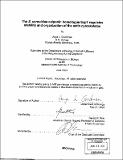The S. cerevisiae calponin homologue SCP1 regulates stability and organization of the actin cytoskeleton
Author(s)
Goodman, Anya L., 1973-
DownloadFull printable version (5.927Mb)
Alternative title
Saccharomyces cerevisiae calponin homologue SCP1 regulates stability and organization of the actin cytoskeleton
Other Contributors
Massachusetts Institute of Technology. Dept. of Biology.
Advisor
Gerald R. Fink.
Terms of use
Metadata
Show full item recordAbstract
Calponins and transgelins are members of a conserved family of actin-associated proteins widely expressed from yeast to humans. While a role for calponin in muscle cells has been described, the biochemical activities and in vivo functions of non-muscle calponins and transgelins are largely unknown. I have used genetic and biochemical analyses to characterize the budding yeast member of this family, Scpl, which most closely resembles transgelin and contains one calponin homology (CH) domain. I showed that Scpl is a novel component of yeast cortical actin patches and shares in vivo functions and biochemical activities with Sac6/fimbrin, the one other actin patch component that contains CH domains. Similar to Sac6, purified Scpl binds directly to actin, cross-links actin filaments, and stabilizes filaments against disassembly. Furthermore, Scpl competes with Sac6 for binding to actin filaments and may share an overlapping binding site on actin. Overexpression of SCP1 suppresses sac6defects and deletion of SCP1 enhances sac6 defects. Together, these data show that Scpl and Sac6/fimbrin function together to stabilize and organize the yeast actin cytoskeleton. I used the genetic interactions between SCP1 and SAC6 to develop the first in vivo assay for function of any transgelin-like protein and established that actin binding is important for at least some Scpl functions. Sequences necessary and sufficient for actin cross-linking were identified in the carboxyl terminus of Scpl, outside the CH domain. Scpl may regulate actin cytoskeleton not only via direct binding to actin filaments, but also via its interaction with another actin binding protein, Abpl. Scpl and Abpl physically interact in a yeast two hybrid and co-immunoprecipitation assays. In vivo patch localization of Scp1 mutant defective for binding to actin filaments requires src-homology 3 (SH3) domain of Abpl. In vitro, Scpl specifically modulates Abpl-dependent activation of the Arp2/3 complex. In summary, Scpl may function in complex with Abpl to regulate actin nucleation by the Arp2/3 complex.
Description
Thesis (Ph. D.)--Massachusetts Institute of Technology, Dept. of Biology, 2003. Includes bibliographical references (p. 149-164).
Date issued
2003Department
Massachusetts Institute of Technology. Department of BiologyPublisher
Massachusetts Institute of Technology
Keywords
Biology.